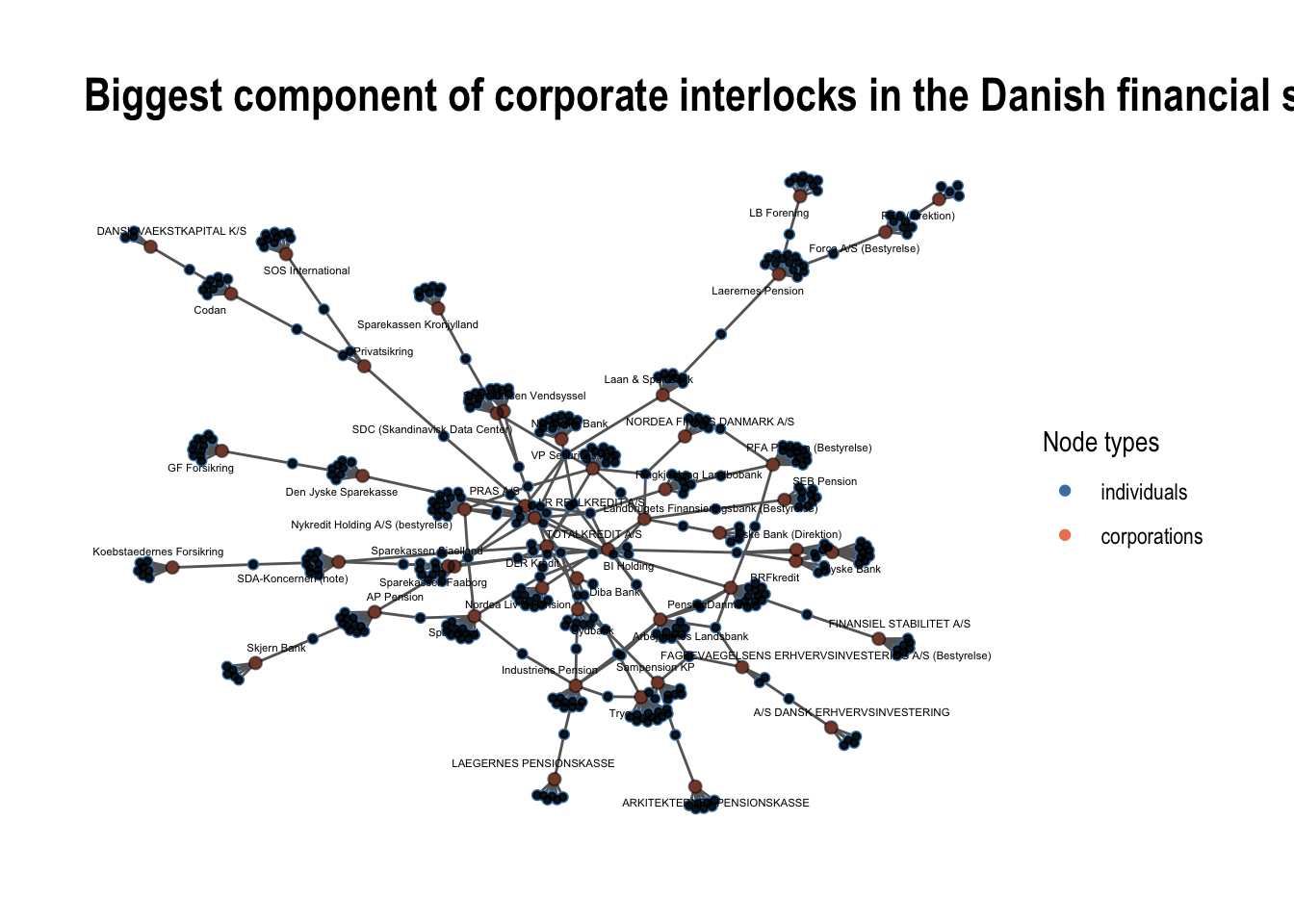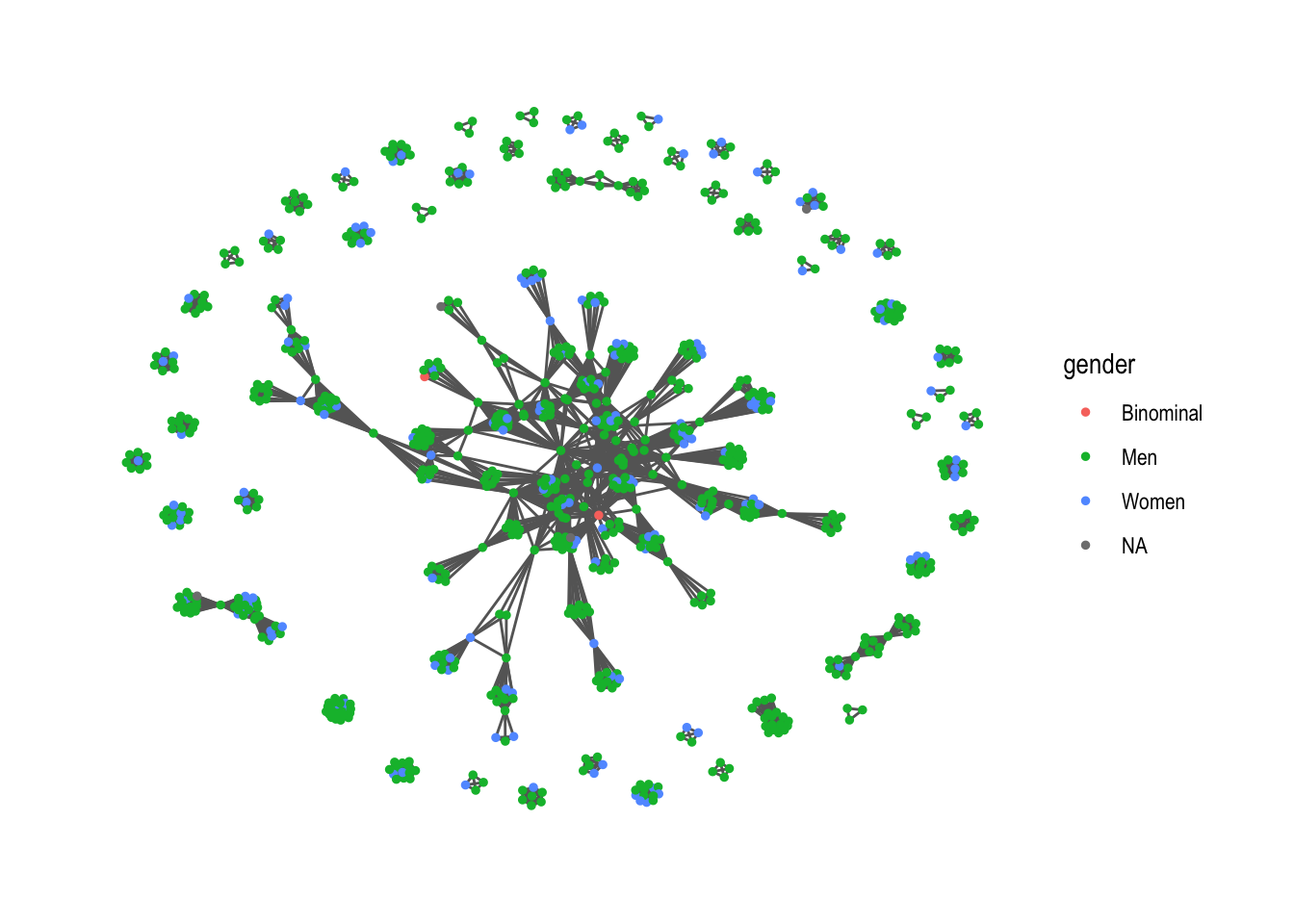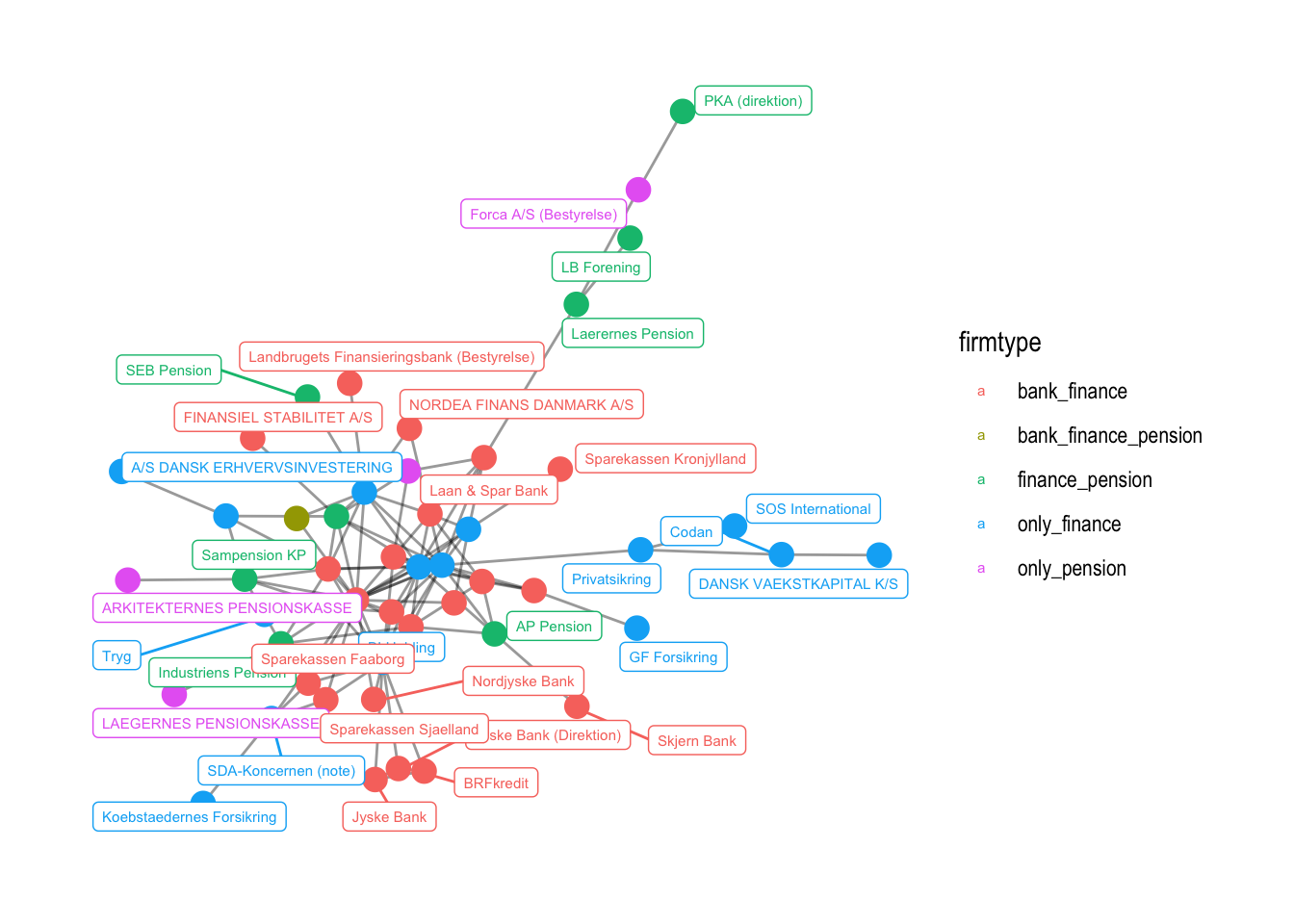Session 3 - Collecting network data

Table of Contents
Session 3 - collection and construction of network data #
In this session, you are faced with an important decision in regard to data collection for your exam projects. There are three possibilities:
-
You use the
den17data set, find a subset and analyze it with appropriate tools covered during the course -
You collect data using
orbis, find a suitable subset and analyze it with appropriate tools covered during the course -
You collect your own relational data, create a graph object and analyze it with appropriate tools covered during the course
First, I will highlight how you can find subsets of the data set den17. We start by setting our working directory using setwd() and loading our packages. We load the data set den17 and filter the sector column by corporations.
This time, we also load an additional R.file called custom_functions.R which can be downloaded below. Please place this R.file in your r folder.
## load working directory
setwd("/Users/alexandergamerdinger/Desktop/PhD/teaching/virksomhedsstrategi_forår_2022")
# libs
library(data.table)
library(tidyverse)
library(igraph)
library(ggraph)
library(readxl)
library(writexl)
library(graphlayouts)
source("r/custom_functions.R")
# Load and manipulate data set --------------------------------------------
# Load
den <- read_csv("input/den17-no-nordic-letters.csv")
# we'll be looking only at corporations, that have a valid company ID in the
# Danish register for firms (the CVR register)
den1 <-
den %>%
filter(sector == "Corporations") %>%
filter(!is.na(cvr_affiliation))
We load the custom_functions.R file by putting it into the source() function. After this is done and executed, we have loaded, among others, the following custom functions into our environment:
-
the function
show.all.tags()which allows us to see all the tags of the data setden. This can be applied either on the raw data set or on any subset ofdenthat contains the same column structure -
the function
has.tags()which allows us to subset the data setdenby specific tags -
the function
clean_orbis()which loads an excel file from Orbis, selects a specific set of columns and cleans them
3.1 Sub-setting the data set den #
We can see all tags of the raw data set den by using the function show.all.tags(). Below, only the first 20 entries are shown.
# all tags of company boards
show.all.tags(den1)[1:20, ]
## Positions affiliations
## Animals 27 3
## Architecture 93 14
## Banks 354 36
## BILH 186 44
## Business 8 1
## BYGG 282 43
## Charity 16 1
## Children 8 1
## Clothing 11 1
## Commerce 46 6
## Commercials 37 7
## Communication 51 12
## Construction 48 8
## Consultants 97 21
## Consumers 11 1
## Corporation 7322 1120
## Counseling 5 1
## Culture 159 23
## Design 13 2
## DETH 184 28
To actually subset the data set, we can use the has.tags() function. This function can be applied to each tag (or several tags) that are found in the list above. There are three output options: the option "den", which reproduces the den17 data set, the option “affil" which gives a vector of affiliations and the option "name" which gives a vector of names.
The R chunk below only shows the first 20 rows for each output.
# suppose we want to get a subset of den1 that includes all names and affiliations with the tag "Banks"
bank <- has.tags(den1, "Banks", result = "den")
## Matched positions
## Banks 354
##
##
# now, we only want the UNIQUE affiliations
bank1 <- has.tags(den1, "Banks", result = "affil")
## Matched positions
## Banks 354
##
##
# and only UNIQUE names
bank2 <- has.tags(den1, "Banks", result = "name")
## Matched positions
## Banks 354
##
##
# we can also subset by several tags, first we make a vector
tags <- c("Banks", "Finance", "Pensions")
# this gives us the whole data tibble
finance <- has.tags(den1, tags, result = "den")
## Matched positions
## Banks 354
## Finance 881
## Pensions 217
##
##
finance[1:20, ]
## # A tibble: 20 × 17
## name affil…¹ role tags posit…² id sector type descr…³
## <chr> <chr> <chr> <chr> <dbl> <dbl> <chr> <chr> <chr>
## 1 Aage Almtoft Middel… Memb… Corp… 1 95023 Corpo… <NA> Automa…
## 2 AAke Per-Urban Bäcks… Danske… Vice… Corp… 416 132356 Corpo… <NA> Automa…
## 3 Alice Lykke SEB Pe… Memb… Corp… 689 97986 Corpo… <NA> Automa…
## 4 Allan Buch Middel… Chai… Corp… 785 95018 Corpo… <NA> Automa…
## 5 Allan Michael Luplau Sygefo… Chie… Corp… 1064 99077 Corpo… <NA> Automa…
## 6 Amund Skarholt SOS In… Chai… Corp… 1274 98467 Corpo… <NA> Automa…
## 7 Anders Bondo Christe… Laerer… Chai… Corp… 1364 58555 Corpo… Virk… Formand
## 8 Anders Bondo Christe… Laan &… Chai… Corp… 1384 94515 Corpo… <NA> Automa…
## 9 Anders Buhl-Christen… Sparek… Memb… Corp… 1420 98558 Corpo… <NA> Automa…
## 10 Anders Christen Obel ERHVER… Memb… Corp… 1459 87665 Corpo… <NA> Automa…
## 11 Anders Christian Dam BRFkre… Chai… Bank… 1514 128889 Corpo… <NA> Automa…
## 12 Anders Christian Dam Jyske … Exec… Corp… 1518 93008 Corpo… <NA> Automa…
## 13 Anders Eldrup JURIST… Chai… Corp… 1650 92935 Corpo… <NA> Automa…
## 14 Anders Hjulmand Tryg Memb… Corp… 1870 130413 Corpo… <NA> Automa…
## 15 Anders Jensen 677 Nykred… Exec… Bank… 1979 96205 Corpo… Virk… Automa…
## 16 Anders Kristian Bech Vestjy… Memb… Corp… 2111 100297 Corpo… <NA> Automa…
## 17 Anders Rasmussen 827 MP PEN… <NA> Corp… 2416 111468 Corpo… Virk… Cand.s…
## 18 Anette Eberhard Alm. B… Memb… Corp… 3090 82511 Corpo… <NA> Automa…
## 19 Anker Boye Sampen… Chai… Corp… 3503 58509 Corpo… Virk… (forma…
## 20 Anne Gleerup Sparek… Vice… Corp… 4071 98559 Corpo… <NA> Automa…
## # … with 8 more variables: created <dttm>, archived <dttm>,
## # last_checked <dttm>, cvr_person <dbl>, cvr_affiliation <dbl>,
## # person_id <dbl>, affiliation_id <dbl>, gender <chr>, and abbreviated
## # variable names ¹affiliation, ²position_id, ³description
Some people and affiliations can have several tags. To find people with several tags, we filter the data by the tags we are interested in, and then use the intersect() function.
a1 <- den1 %>% filter(grepl("Farming", tags)) %>% pull(name)
b1 <- den1 %>% filter(grepl("Banks", tags)) %>% pull(name)
c1 <- intersect(a1, b1)
3.2 Downloading data from Orbis #
Second, I highlight how you can collect data from Orbis. As a student of CBS, you have free access to Orbis, which is a website that contains information about corporations around the world. Orbis is just one available option to collect data. Feel free to use others as well.
To download data from Orbis, please follow the steps explained in this video. Please note, that Lasse recorded this video in 2020, and some filters have changed since then. This means that while you are able to reproduce the same filter choices, you will get different results.
For this exercise class, I have created a different data set than what you see in the video. Specifically, I have applied the following filters which you can see in the image below.

The data set that you can download here contains information about all public limited Companies in Copenhagen. You can download it by pressing the button below.
Download Orbis dataIf you follow the video above and add columns that include information about the shareholders, their titles, and their unique identification number, you can use the function clean_orbis() which I have created to make your lives a little easier. The function cleans the column names, certain data entries and classes and returns structure that is similar to the den17 data set.
df <- clean_orbis(path = "input/public_companies_cph.xlsx")
## New names:
## • `` -> `...1`
glimpse(df)
## Rows: 31,444
## Columns: 8
## $ name <chr> "Mr Ane Maersk Mc-Kinney Uggla", "Mr Lars Erik Brenoe", "M…
## $ affiliation <chr> "A.P. MOLLER HOLDING A/S", "A.P. MOLLER HOLDING A/S", "A.P…
## $ title <chr> "Chairman (Board of Directors)", "Director (Board of Direc…
## $ id <chr> "P043421359", "P041964972", "P645698736", "P041410476", "P…
## $ sector <chr> "6499", "6499", "6499", "6499", "6499", "6499", "6499", "6…
## $ revenue <dbl> 62187559, 62187559, 62187559, 62187559, 62187559, 62187559…
## $ n_employees <dbl> 93076, 93076, 93076, 93076, 93076, 93076, 93076, 93076, 93…
## $ gender <chr> "male", "male", "female", "male", "male", "male", "male", …
If you add other columns than specified in the video above, the function clean_orbis() might produce errors. The clean_orbis() function enables you to use all remaining functions, such as creating an incidence matrix and a graph object, just like with the data set den17. There is no need to rename columns.
Please note, that Orbis data is “real data” in the sense that it is not completely clean. Depending on your data set, you have to undertake further cleaning operations. Some of those can be seen in the r-script that can be found below under materials.
3.3 Loading and visualizing a two-mode network #
After we have found a suitable subset of our data, we are ready to load a graph object. Since both den17 and Orbis data have two columns (name and affiliation) which are used as input variables for our graph object, we always load data by first creating an incidence matrix.
There are also different ways of loading graph objects, such as through the igraph functions graph_from_data_frame() or graph_from_edgelist(). However, I only recommend to use these functions if you are dealing with an edge list or data frame that shows connections between entities of the same unit (one-mode edge lists). If the raw data contains a two-mode edge list (as in den17 or in Orbis), it is better to load graph objects through an incidence or adjacency matrix.
Since we already covered on how to load a graph object through an incidence or adjacency matrix here, I will just show the code.
incidence <- xtabs(formula = ~ name + affiliation, data = finance, sparse = TRUE)
adj_i <- incidence %*% Matrix::t(incidence)
adj_c <- Matrix::t(incidence) %*% incidence
# 2. Loading two-mode network "gr" and one-mode networks "gr1" and "gr2"
gr <- graph_from_incidence_matrix(incidence, directed = FALSE) %>%
simplify(remove.multiple = TRUE, remove.loops = TRUE)
gr1 <- graph_from_adjacency_matrix(adj_i, mode = "undirected") %>%
simplify(remove.multiple = TRUE, remove.loops = TRUE)
gr2 <- graph_from_adjacency_matrix(adj_c, mode = "undirected") %>%
simplify(remove.multiple = TRUE, remove.loops = TRUE)
# look at gr
gr
## IGRAPH c51ee69 UN-B 920 931 --
## + attr: type (v/l), name (v/c)
## + edges from c51ee69 (vertex names):
## [1] Aage Almtoft --Middelfart Sparekasse
## [2] AAke Per-Urban Bäckström--Danske Bank
## [3] AAse Kogsboell --JURISTERNES OG OEKONOMERNES PENSIONSKASSE
## [4] Alice Lykke --SEB Pension
## [5] Allan Bisgaard --Koebstaedernes Forsikring
## [6] Allan Buch --Middelfart Sparekasse
## [7] Allan Kragh Thaysen --Nykredit Forsikring (note)
## [8] Allan Michael Luplau --Sygeforsikring Danmark
## + ... omitted several edges
Visualizing two-mode networks is very similar to visualizing one-mode networks. Two mode networks have an attribute called type which you can see just above. It is a node attribute.
When we visualize two-mode networks, we need to make the type of the node visible, because otherwise, we will not know which node is a corporation and person respectively. We specify this by using the color argument.
gr %>%
ggraph("fr") +
geom_edge_link0(color = "gray40") +
geom_node_point(aes(color = type)) +
geom_node_point(aes(filter=type==FALSE), alpha = 0.8, size = 1) +
geom_node_point(aes(filter=type==TRUE), alpha = 0.5, size = 2) +
# changing the legend content
scale_color_manual(values = c("steelblue", "salmon2"),
labels = c("individuals", "corporations")) +
labs(title = "Corporate interlocks in the Danish financial sector",
# changing the legend header
color = "Node types") +
theme_graph()

We select the largest component exactly as we do with one-mode networks too. Let us select the largest component and visualize it.
# Select largest component
complist <- components(gr)
comps <- decompose.graph(gr)
# make index
index <-
table(complist$membership) %>%
as_tibble(.name_repair = make.names) %>%
arrange(desc(n)) %>%
mutate(X = as.numeric(X)) %>%
pull(1)
# select biggest
comp1 <- comps[[index[1]]]
# visualize
comp1 %>%
ggraph("fr") +
geom_edge_link0(color = "gray40") +
geom_node_point(aes(color = type)) +
geom_node_point(aes(filter=type==FALSE), alpha = 0.8, size = 1) +
geom_node_point(aes(filter=type==TRUE), alpha = 0.5, size = 2) +
geom_node_text(aes(filter=type==TRUE, label = name), size = 1.5,
# no overlap
repel = TRUE) +
# changing the legend content
scale_color_manual(values = c("steelblue", "salmon2"),
labels = c("individuals", "corporations")) +
labs(title = "Biggest component of corporate interlocks in the Danish financial sector",
# changing the legend header
color = "Node types") +
theme_graph()

3.4 Adding graph attributes to one-mode networks #
If you want to visualize certain aspects of the underlying raw data, you have to first add them as graph attributes. Adding attributes from the original raw data can be more complicated than adding graph-specific attributes such as distance or degree.
3.4.1 Attributes for person one-mode network #
Here, I show how you can add the gender of the person as a graph attribute.
# we want to add attributes to the person one-mode network gr1
# first, make a tibble where you make a name and gender column
a1 <- tibble(
name = V(gr1)$name,
gender = finance %>% count(name, gender) %>% pull(gender)
)
# second, check if the sequence of names are similar in the tibble and the graph object and then add it
all.equal(V(gr1)$name, a1$name)
## [1] TRUE
# add it as a vertex attribute
V(gr1)$gender <- a1$gender
# visualize
gr1 %>%
ggraph("fr") +
geom_edge_link0(color = "gray40") +
geom_node_point(aes(color = gender), size = 1) +
theme_graph()

3.4.1 Attributes for corporate one-mode network #
Here, I show how you can add the sector of a corporation as a graph attribute
# remember that the corporate network is made from the object finance which includes the tags Banks, Finance and Pension
# first, we make an affiliation sub set for each.
bank <- has.tags(den1, "Banks", "affil")
## Matched positions
## Banks 354
##
##
fin <- has.tags(den1, "Finance", "affil")
## Matched positions
## Finance 881
##
##
pension <- has.tags(den1, "Pensions", "affil")
## Matched positions
## Pensions 217
##
##
# second, we create a data frame which binds three data frames together into one. We give each node a tag name.
a1 <- rbind(
tibble(name=fin, tag ="finance"),
tibble(name=bank, tag ="bank"),
tibble(name=pension, tag ="pension")
)
# second, we make an incidence matrix
a2 <- xtabs(formula = ~ name + tag, data = a1, sparse = T)
# change matrix to tibble format
a2 <- a2 %>% as.matrix() %>% as_tibble(rownames = "name")
# let us look at the object
a2
## # A tibble: 108 × 4
## name bank finance pension
## <chr> <dbl> <dbl> <dbl>
## 1 A/S DANSK ERHVERVSINVESTERING 0 1 0
## 2 ALD Automotive 0 1 0
## 3 Alm. Brand 0 1 0
## 4 Alpha Holding 0 1 0
## 5 ALTOR EQUITY PARTNERS A/S 0 1 0
## 6 AP Pension 0 1 1
## 7 Arbejdernes Landsbank 1 1 0
## 8 ARKITEKTERNES PENSIONSKASSE 0 0 1
## 9 Bank DNB Nord 1 1 0
## 10 BDO - Statsautoriseret revisionsaktieselskab (bestyrel… 0 1 0
## # … with 98 more rows
The object a2 denotes 1 if a corporation belongs to a sector and 0 if it does not. With this information, we can use the filter() function to make vectors with different names depending on the possible firm types. Consequently, each firm type is assigned to the firmtpye attribute.
# make vectors with different names depending on the possible firm types
only_bank <- a2 %>% filter(bank==1 & finance==0 & pension ==0) %>% pull(name)
only_finance <- a2 %>% filter(bank==0 & finance==1 & pension ==0) %>% pull(name)
only_pension <- a2 %>% filter(bank==0 & finance==0 & pension ==1) %>% pull(name)
bank_finance <- a2 %>% filter(bank==1 & finance==1 & pension ==0) %>% pull(name)
bank_pension <- a2 %>% filter(bank==1 & finance==0 & pension ==1) %>% pull(name)
finance_pension <- a2 %>% filter(bank==0 & finance==1 & pension ==1) %>% pull(name)
bank_finance_pension <- a2 %>% filter(bank==1 & finance==1 & pension ==1) %>% pull(name)
# make an empty network attribute
V(gr2)$firmtype <- NA
# rename for reach firm type
V(gr2)$firmtype[which(V(gr2)$name %in% only_bank)] <- "only_bank"
V(gr2)$firmtype[which(V(gr2)$name %in% only_finance)] <- "only_finance"
V(gr2)$firmtype[which(V(gr2)$name %in% only_pension)] <- "only_pension"
V(gr2)$firmtype[which(V(gr2)$name %in% bank_finance)] <- "bank_finance"
V(gr2)$firmtype[which(V(gr2)$name %in% bank_pension)] <- "bank_pension"
V(gr2)$firmtype[which(V(gr2)$name %in% finance_pension)] <- "finance_pension"
V(gr2)$firmtype[which(V(gr2)$name %in% bank_finance_pension)] <- "bank_finance_pension"
# Look at the result
V(gr2)$firmtype
## [1] "only_finance" "only_finance" "only_finance"
## [4] "only_finance" "only_finance" "finance_pension"
## [7] "bank_finance" "only_pension" "bank_finance"
## [10] "only_finance" "only_finance" "only_finance"
## [13] "bank_finance" "only_finance" "only_finance"
## [16] "only_finance" "only_finance" "only_finance"
## [19] "finance_pension" "only_finance" "bank_finance"
## [22] "bank_finance" "only_finance" "bank_finance"
## [25] "bank_finance" "bank_finance" "only_finance"
## [28] "bank_finance" "bank_finance" "only_finance"
## [31] "only_finance" "only_finance" "bank_finance"
## [34] "bank_finance" "only_pension" "only_finance"
## [37] "only_finance" "finance_pension" "only_finance"
## [40] "only_pension" "only_finance" "bank_finance"
## [43] "bank_finance" "only_finance" "only_finance"
## [46] "only_finance" "bank_finance" "only_pension"
## [49] "finance_pension" "bank_finance" "finance_pension"
## [52] "only_finance" "only_finance" "only_finance"
## [55] "only_finance" "only_finance" "bank_finance"
## [58] "finance_pension" "only_finance" "bank_finance"
## [61] "only_finance" "bank_finance_pension" "bank_finance_pension"
## [64] "bank_finance" "only_finance" "only_finance"
## [67] "only_finance" "bank_finance" "bank_finance"
## [70] "only_finance" "bank_finance" "finance_pension"
## [73] "finance_pension" "finance_pension" "only_pension"
## [76] "finance_pension" "only_finance" "only_finance"
## [79] "only_finance" "only_finance" "bank_finance"
## [82] "finance_pension" "only_finance" "only_finance"
## [85] "only_finance" "only_finance" "only_finance"
## [88] "only_finance" "finance_pension" "finance_pension"
## [91] "bank_finance" "only_finance" "bank_finance"
## [94] "bank_finance" "bank_finance" "bank_finance"
## [97] "bank_finance" "bank_finance" "bank_finance"
## [100] "bank_finance" "only_finance" "only_finance"
## [103] "only_finance" "only_finance" "only_finance"
## [106] "bank_finance" "only_finance" "bank_finance"
Last, we select the largest component, and visualize the network with firmtype as the color node attribute.
# Select largest component
complist <- components(gr2)
comps <- decompose.graph(gr2)
index <-
table(complist$membership) %>%
as_tibble(.name_repair = make.names) %>%
arrange(desc(n)) %>%
mutate(X = as.numeric(X)) %>%
pull(1)
comp1 <- comps[[index[1]]]
# visualize
comp1 %>%
ggraph(layout = "fr") +
geom_edge_link0(width=.5, alpha=0.4) +
geom_node_point(aes(color=firmtype), size=4) +
geom_node_label(aes(color=firmtype, label=name), size=2, nudge_y=-0.05, repel=TRUE) +
theme_graph()
## Warning: ggrepel: 18 unlabeled data points (too many overlaps). Consider
## increasing max.overlaps
